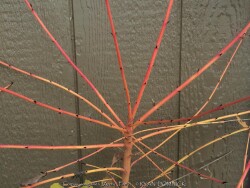

Arctic Sun® Dogwood (Cornus sanguinea 'Arctic Sun') is a new color breakthrough from Proven Winners! Set your winter landscape ablaze with color! Keep your landscape lively even in winter with the glorious yellow, orange, and coral stems of Arctic Sun® dogwood. It performs like the familiar red-twig dogwoods but with unique color that positively glows in the landscape. Tolerant of a very wide range of soil conditions and one of the best ornamental shrubs for shade, Arctic Sun dogwood is an easy choice for nearly effortless color. Top reasons to grow Arctic Sun dogwood: 1.unusual yellow, orange, and coral stems pop in the winter landscape. 2.easy to grow. 3.deer resistant and shade tolerant. Uses Notes: Beautiful in the landscape or a container to add winter interest. Stems may be cut for winter flower arrangements. Maintenance Notes: The best red color appears on one and two year old stems; older stems will turn corky and brown. To maintain a colorful display, you can do one of two things: one, cut the whole plant back to short stubs every other year. Two, cut out one-third of the oldest stems every year. This option is recommended if you planted your Arctic Fire® dogwood to provide coverage. Early spring is the best time to prune. If desired, apply a granular fertilizer formulated for trees and shrubs at pruning time. In Eastern Kansas, this cultivar performs WELL with just about everything nature has to challenge it! Heat and drought are tolerated if in shade or morning sun. Cold tolerance is no problem. No disease or pest problems. Great plant for dry-shade. After 10 years and despite a slow growth rate, it is advisable to rejuvinate this shrub down to the ground as it will reach 5-6 feet tall eventually. Especially effective against dark backgrounds! All Proven Winners® plants are legally propagated, healthy and vigorous, true to name, and tagged with color pictures and growing information.
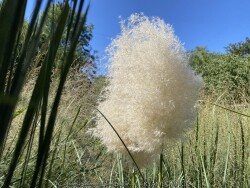

***Description for this plant available with future update!*** Cortaderia selloana 'Blue Bayou' is hardy to zone 6b.
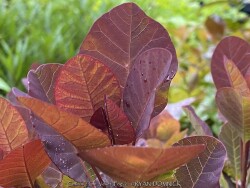

>>>>>In the words of breeder Tim Wood - "It's got more smoke than a KISS concert!" (Cotinus 'The Velvet Fog') Very large pink plumes develop in mid-summer, covering the waxy blue-green foliage. It's a stunning color combination. The Velvet Fog smokebush (Cotinus 'The Velvet Fog') was selected for its outstanding flower production as well as its dense growth, providing a lusher look than conventional cotinus. Pruning will rarely be required but may be done in spring. It isn't technically the flowers that create the hazy, smoke-like effect this plant is so loved for - it's the seed pods that form after the flowers have faded. In Eastern Kansas, this cultivar performs WELL with just about everything nature has to challenge it! Heat and drought are preferred and need hot microclimate. Cold tolerance is no problem. Some leaf disease appears by late season from excessive rains and high humidity sometimes causing early defoliation. An important note about pruning: Do not attempt to rejuvinate an older tree/shrub in early fall. This will trick it into growing back rapidly to recover and them WHAM!.Arctic cold blast arrives killing any new growth not hardened off. This double sapps the tree for nutrients usually resulting in death by spring. All Proven Winners® plants are legally propagated, healthy and vigorous, true to name, and tagged with color pictures and growing information.
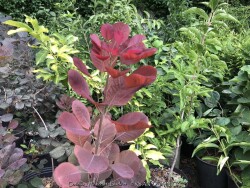

>>>>>A feast for the eyes from spring through autumn! Winecraft Black® Smoketrtee (Cotinus 'Winecraft Black') is the first Proven Winners smokebush, so you know it must be special. In spring, round leaves emerge rich purple but as summer's heat comes on, they turn a deep near-black tone and finally light up in an array of reds and oranges in fall. In early summer, large, soft panicles of bloom appear that become the misty "smoke" that makes this such a popular landscape plant. Unlike other smokebush, it naturally has a rounded, dwarf habit which means that finally, every landscape has room for this unique plant. Top three reasons to grow Winecraft Black smokebush: 1.Color and interest from spring through frost. 2.No pruning or special maintenance required. 3.Dwarf habit makes it easy to use with any sized home or yard. Uses Notes: Smokebush makes a striking specimen, but is also effective as a low hedge or mass planting. Maintenance Notes: Winecraft Black smokebush is very easy to care for and requires little to nothing in the way of regular maintenance. Plant in full sun for best color and flowering. Pruning will rarely be required but may be done in spring. It isn't technically the flowers that create the hazy, smoke-like effect this plant is so loved for - it's the seed pods that form after the flowers have faded. In Eastern Kansas, this cultivar performs WELL with just about everything nature has to challenge it! Heat and drought are preferred and need hot microclimate. Cold tolerance is no problem. Some leaf disease appears by late season from excessive rains and high humidity sometimes causing early defoliation. An important note about pruning: Do not attempt to rejuvinate an older tree/shrub in early fall. This will trick it into growing back rapidly to recover and them WHAM!.Arctic cold blast arrives killing any new growth not hardened off. This double sapps the tree for nutrients usually resulting in death by spring. All Proven Winners® plants are legally propagated, healthy and vigorous, true to name, and tagged with color pictures and growing information.


>>>>>A beaming beacon for the landscape. Bold, bright, and beautiful: that's Winecraft Goldtm Smokebush (). Round, waxy leaves emerge a sunny orange, soon take on a golden hue, then mature to a cheerful chartreuse for the season. In early summer, cloud-like green flower clusters cover the plant, and these turn into the pink "smoke" plumes that earn the plant its name. Naturally grows with a dense, oval shape that's ideal for adding a spot of bright color to partially shaded or sunny areas. Top reasons to grow Winecraft Gold smokebush: 1. bright golden foliage, 2. memorable smoke-like seedheads in summer, 3. smaller and more dense than conventional smokebush. Uses Notes: Makes a lovely specimen or addition to perennial gardens and flower borders. Maintenance Notes: It's best to avoid pruning smokebush regularly, though you may selectively remove branches to attain the shape you desire. It's quite versatile and easy to grow, but do note that this golden selection is a bit less cold tolerant than other smokebush. In Eastern Kansas, this cultivar performs WELL with just about everything nature has to challenge it! Heat and drought are preferred and need hot microclimate. Cold tolerance is no problem. Some leaf disease appears by late season from excessive rains and high humidity sometimes causing early defoliation. An important note about pruning: Do not attempt to rejuvinate an older tree/shrub in early fall. This will trick it into growing back rapidly to recover and them WHAM!.Arctic cold blast arrives killing any new growth not hardened off. This double sapps the tree for nutrients usually resulting in death by spring. All Proven Winners® plants are legally propagated, healthy and vigorous, true to name, and tagged with color pictures and growing information.
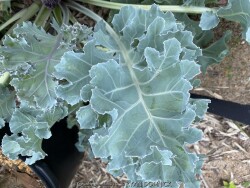

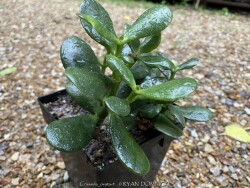

Jade Plant (Crassula ovata) is typically grown in warmer zones. Considered a tropical or succulent in Kansas and used as summer patio plants with white flowers and bright green foliage. Grow in full sun to part sun with optional extra watering during hot weather including that which comes from rainfall. Plants with plenty of time to acclimate will thrive in full sun but be careful not to rush it or sunburning will occur. Generally if moving outside for the summer, allow 2-3 weeks of part shade or morning sun before placing in full sun. Or just keep in part shade or under an overhang. Repotting may or may not be needed depending on how large you want the plant to grow; plants can continue to grow and tolerate extremely root-bound pots but may need wind bracing. Jade Plant can tolerate brief frosts but protect from temperatures below 29 degrees F for more than a few hours. As a permanent house plant, provide bright light and allow the soil to dry between waterings for many years of carefree enjoyment. Potted plants are very low maintenance but the combination of wet and cold will cause problems.
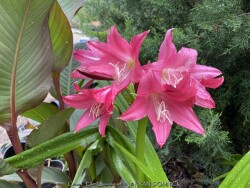

Crinums are tough, long-lived perennial bulbs with strappy leaves and fragrant, funnel-shaped flowers. In areas where the bulbs are hardy, (zones 5/6-10) these plants can reach as much as 4 feet across and bloom all summer. Crinums can live for 200-300 years in the South often found growing in cemeteries and abandoned home sites with little or no attention. The plants are native to southeast Asia often in areas with a summer monsoon and dry winter. They can also be grown as flowering summer patio plants. If growing as a potted plant and trying to overwinter, allowing the foliage to frost is ok, it will not kill the root system. However, do not allow the pot with rootball to freeze solid or go below 20 degrees for more than a few hours; move into a cold garage or basement over the winter with no watering. Cut back and allow to go dormant and place entire pot back out in April or May with a time-release fertilizer. During the growing season, fertilize, water regularly, and place in full sun. You may also plant these in the ground for an enormous tropical effect! It is easy to overwinter these in the ground in Kansas with mulch or no mulch! The trick is to plant them deep: an extra 4-6" deeper than grade or with neck of bulb completely buried. Crinums are extremely adaptable thriving in either in dry or in boggy soils. Crinums are tough, low maintenance bulbs which make them perfect for rain gardens, and although drought-tolerant, crinums bloom more if well-watered. This plant can also grow in standing water or as a potted plant in water gardens. Unlike southern climates, crinums in Kansas need full sun to grow and flower in our shorter growing season. Crinum are more cold hardy than most authorities publish; easily pushing into zone 5 for some varieties. In our trial gardens in Lawrence, KS (zone 6a), the following varieties survived after being mulched 6-12" with leaf mulch to -17 degrees F. (Crinum 'Infusion', Crinum tweedianum, Crinum 'Super Ellen', Crinum x powellii, Crinum 'White Prince') During the arctic blast of February, 2021, lows down to -17 degrees F on Feb 16th, 2021 were recorded. The longevity of this cold blast was also impressive: 10 days on a row with highs of 10-15 degrees F or lower, 8 nights of lows in the single digits and negatives, and 36 straight hours of 0 degrees F and mostly lower. No crinums were lost or harmed during this event! Crinum 'Ellen Bosanquet' has dark magenta/red flowers 24" tall
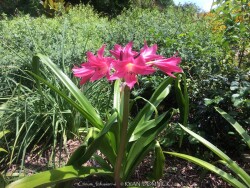

Crinums are tough, long-lived perennial bulbs with strappy leaves and fragrant, funnel-shaped flowers. In areas where the bulbs are hardy, (zones 5/6-10) these plants can reach as much as 4 feet across and bloom all summer. Crinums can live for 200-300 years in the South often found growing in cemeteries and abandoned home sites with little or no attention. The plants are native to southeast Asia often in areas with a summer monsoon and dry winter. They can also be grown as flowering summer patio plants. If growing as a potted plant and trying to overwinter, allowing the foliage to frost is ok, it will not kill the root system. However, do not allow the pot with rootball to freeze solid or go below 20 degrees for more than a few hours; move into a cold garage or basement over the winter with no watering. Cut back and allow to go dormant and place entire pot back out in April or May with a time-release fertilizer. During the growing season, fertilize, water regularly, and place in full sun. You may also plant these in the ground for an enormous tropical effect! It is easy to overwinter these in the ground in Kansas with mulch or no mulch! The trick is to plant them deep: an extra 4-6" deeper than grade or with neck of bulb completely buried. Crinums are extremely adaptable thriving in either in dry or in boggy soils. Crinums are tough, low maintenance bulbs which make them perfect for rain gardens, and although drought-tolerant, crinums bloom more if well-watered. This plant can also grow in standing water or as a potted plant in water gardens. Unlike southern climates, crinums in Kansas need full sun to grow and flower in our shorter growing season. Crinum are more cold hardy than most authorities publish; easily pushing into zone 5 for some varieties. In our trial gardens in Lawrence, KS (zone 6a), the following varieties survived after being mulched 6-12" with leaf mulch to -17 degrees F. (Crinum 'Infusion', Crinum tweedianum, Crinum 'Super Ellen', Crinum x powellii, Crinum 'White Prince') During the arctic blast of February, 2021, lows down to -17 degrees F on Feb 16th, 2021 were recorded. The longevity of this cold blast was also impressive: 10 days on a row with highs of 10-15 degrees F or lower, 8 nights of lows in the single digits and negatives, and 36 straight hours of 0 degrees F and mostly lower. No crinums were lost or harmed during this event! Crinum 'Infusion' is a large crinum up to 48" tall with magenta flowers. Offsets heavily. Hardy to Zone 5b.


Crinums are tough, long-lived perennial bulbs with strappy leaves and fragrant, funnel-shaped flowers. In areas where the bulbs are hardy, (zones 5/6-10) these plants can reach as much as 4 feet across and bloom all summer. Crinums can live for 200-300 years in the South often found growing in cemeteries and abandoned home sites with little or no attention. The plants are native to southeast Asia often in areas with a summer monsoon and dry winter. They can also be grown as flowering summer patio plants. If growing as a potted plant and trying to overwinter, allowing the foliage to frost is ok, it will not kill the root system. However, do not allow the pot with rootball to freeze solid or go below 20 degrees for more than a few hours; move into a cold garage or basement over the winter with no watering. Cut back and allow to go dormant and place entire pot back out in April or May with a time-release fertilizer. During the growing season, fertilize, water regularly, and place in full sun. You may also plant these in the ground for an enormous tropical effect! It is easy to overwinter these in the ground in Kansas with mulch or no mulch! The trick is to plant them deep: an extra 4-6" deeper than grade or with neck of bulb completely buried. Crinums are extremely adaptable thriving in either in dry or in boggy soils. Crinums are tough, low maintenance bulbs which make them perfect for rain gardens, and although drought-tolerant, crinums bloom more if well-watered. This plant can also grow in standing water or as a potted plant in water gardens. Unlike southern climates, crinums in Kansas need full sun to grow and flower in our shorter growing season. Crinum are more cold hardy than most authorities publish; easily pushing into zone 5 for some varieties. In our trial gardens in Lawrence, KS (zone 6a), the following varieties survived after being mulched 6-12" with leaf mulch to -17 degrees F. (Crinum 'Infusion', Crinum tweedianum, Crinum 'Super Ellen', Crinum x powellii, Crinum 'White Prince') During the arctic blast of February, 2021, lows down to -17 degrees F on Feb 16th, 2021 were recorded. The longevity of this cold blast was also impressive: 10 days on a row with highs of 10-15 degrees F or lower, 8 nights of lows in the single digits and negatives, and 36 straight hours of 0 degrees F and mostly lower. No crinums were lost or harmed during this event! Crinum 'Glory' is a large crinum up to 48" tall with magenta flowers. Offsets heavily. Hardy to Zone 5b.
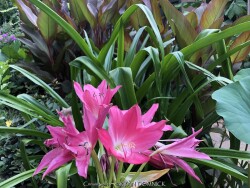

Crinums are tough, long-lived perennial bulbs with strappy leaves and fragrant, funnel-shaped flowers. In areas where the bulbs are hardy, (zones 5/6-10) these plants can reach as much as 4 feet across and bloom all summer. Crinums can live for 200-300 years in the South often found growing in cemeteries and abandoned home sites with little or no attention. The plants are native to southeast Asia often in areas with a summer monsoon and dry winter. They can also be grown as flowering summer patio plants. If growing as a potted plant and trying to overwinter, allowing the foliage to frost is ok, it will not kill the root system. However, do not allow the pot with rootball to freeze solid or go below 20 degrees for more than a few hours; move into a cold garage or basement over the winter with no watering. Cut back and allow to go dormant and place entire pot back out in April or May with a time-release fertilizer. During the growing season, fertilize, water regularly, and place in full sun. You may also plant these in the ground for an enormous tropical effect! It is easy to overwinter these in the ground in Kansas with mulch or no mulch! The trick is to plant them deep: an extra 4-6" deeper than grade or with neck of bulb completely buried. Crinums are extremely adaptable thriving in either in dry or in boggy soils. Crinums are tough, low maintenance bulbs which make them perfect for rain gardens, and although drought-tolerant, crinums bloom more if well-watered. This plant can also grow in standing water or as a potted plant in water gardens. Unlike southern climates, crinums in Kansas need full sun to grow and flower in our shorter growing season. Crinum are more cold hardy than most authorities publish; easily pushing into zone 5 for some varieties. In our trial gardens in Lawrence, KS (zone 6a), the following varieties survived after being mulched 6-12" with leaf mulch to -17 degrees F. (Crinum 'Infusion', Crinum tweeedianum, Crinum 'Super Ellen', Crinum x powellii, Crinum 'White Prince') During the arctic blast of February, 2021, lows down to -17 degrees F on Feb 16th, 2021 were recorded. The longevity of this cold blast was also impressive: 10 days on a row with highs of 10-15 degrees F or lower, 8 nights of lows in the single digits and negatives, and 36 straight hours of 0 degrees F and mostly lower. No crinums were lost or harmed during this event! Crinum 'Super Ellen' is a massive crinum (cross of Crinum 'Ellen Bosanquet' x Crinum bulbispermum) up to 60" tall with magenta flowers. Offsets heavily.
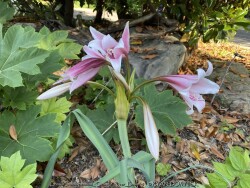

Crinums are tough, long-lived perennial bulbs with strappy leaves and fragrant, funnel-shaped flowers. In areas where the bulbs are hardy, (zones 5/6-10) these plants can reach as much as 4 feet across and bloom all summer. Crinums can live for 200-300 years in the South often found growing in cemeteries and abandoned home sites with little or no attention. The plants are native to southeast Asia often in areas with a summer monsoon and dry winter. They can also be grown as flowering summer patio plants. If growing as a potted plant and trying to overwinter, allowing the foliage to frost is ok, it will not kill the root system. However, do not allow the pot with rootball to freeze solid or go below 20 degrees for more than a few hours; move into a cold garage or basement over the winter with no watering. Cut back and allow to go dormant and place entire pot back out in April or May with a time-release fertilizer. During the growing season, fertilize, water regularly, and place in full sun. You may also plant these in the ground for an enormous tropical effect! It is easy to overwinter these in the ground in Kansas with mulch or no mulch! The trick is to plant them deep: an extra 4-6" deeper than grade or with neck of bulb completely buried. Crinums are extremely adaptable thriving in either in dry or in boggy soils. Crinums are tough, low maintenance bulbs which make them perfect for rain gardens, and although drought-tolerant, crinums bloom more if well-watered. Unlike southern climates, crinums in Kansas need full sun to grow and flower in our shorter growing season. Crinum are more cold hardy than most authorities publish; easily pushing into zone 5 for some varieties. In our trial gardens in Lawrence, KS (zone 6a), the following varieties survived after being mulched 6-12" with leaf mulch to -17 degrees F. (Crinum 'Infusion', Crinum tweedianum, Crinum 'Super Ellen', Crinum x powellii, Crinum 'White Prince') During the arctic blast of February, 2021, lows down to -17 degrees F on Feb 16th, 2021 were recorded. The longevity of this cold blast was also impressive: 10 days on a row with highs of 10-15 degrees F or lower, 8 nights of lows in the single digits and negatives, and 36 straight hours of 0 degrees F and mostly lower. No crinums were lost or harmed during this event! Crinum bulbispermum 'Orange River Basin' is a form of the extremely winter hardy (zone 5) Crinum bulbispermum from South Africa's Orange River area at around 9,000' elevation 'Orange River Basin' forms a lovely non-offsetting clump of glaucous blue foliage and white flowers with pink and magenta throat.
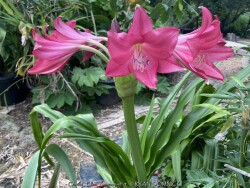

Crinums are tough, long-lived perennial bulbs with strappy leaves and fragrant, funnel-shaped flowers. In areas where the bulbs are hardy, (zones 5/6-10) these plants can reach as much as 4 feet across and bloom all summer. Crinums can live for 200-300 years in the South often found growing in cemeteries and abandoned home sites with little or no attention. The plants are native to southeast Asia often in areas with a summer monsoon and dry winter. They can also be grown as flowering summer patio plants. If growing as a potted plant and trying to overwinter, allowing the foliage to frost is ok, it will not kill the root system. However, do not allow the pot with rootball to freeze solid or go below 20 degrees for more than a few hours; move into a cold garage or basement over the winter with no watering. Cut back and allow to go dormant and place entire pot back out in April or May with a time-release fertilizer. During the growing season, fertilize, water regularly, and place in full sun. You may also plant these in the ground for an enormous tropical effect! It is easy to overwinter these in the ground in Kansas with mulch or no mulch! The trick is to plant them deep: an extra 4-6" deeper than grade or with neck of bulb completely buried. Crinums are extremely adaptable thriving in either in dry or in boggy soils. Crinums are tough, low maintenance bulbs which make them perfect for rain gardens, and although drought-tolerant, crinums bloom more if well-watered. This plant can also grow in standing water or as a potted plant in water gardens. Unlike southern climates, crinums in Kansas need full sun to grow and flower in our shorter growing season. Crinum are more cold hardy than most authorities publish; easily pushing into zone 5 for some varieties. In our trial gardens in Lawrence, KS (zone 6a), the following varieties survived after being mulched 6-12" with leaf mulch to -17 degrees F. (Crinum 'Infusion', Crinum tweedianum, Crinum 'Super Ellen', Crinum x powellii, Crinum 'White Prince') During the arctic blast of February, 2021, lows down to -17 degrees F on Feb 16th, 2021 were recorded. The longevity of this cold blast was also impressive: 10 days on a row with highs of 10-15 degrees F or lower, 8 nights of lows in the single digits and negatives, and 36 straight hours of 0 degrees F and mostly lower. No crinums were lost or harmed during this event!
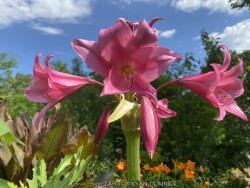

Crinums are tough, long-lived perennial bulbs with strappy leaves and fragrant, funnel-shaped flowers. In areas where the bulbs are hardy, (zones 5/6-10) these plants can reach as much as 4 feet across and bloom all summer. Crinums can live for 200-300 years in the South often found growing in cemeteries and abandoned home sites with little or no attention. The plants are native to southeast Asia often in areas with a summer monsoon and dry winter. They can also be grown as flowering summer patio plants. If growing as a potted plant and trying to overwinter, allowing the foliage to frost is ok, it will not kill the root system. However, do not allow the pot with rootball to freeze solid or go below 20 degrees for more than a few hours; move into a cold garage or basement over the winter with no watering. Cut back and allow to go dormant and place entire pot back out in April or May with a time-release fertilizer. During the growing season, fertilize, water regularly, and place in full sun. You may also plant these in the ground for an enormous tropical effect! It is easy to overwinter these in the ground in Kansas with mulch or no mulch! The trick is to plant them deep: an extra 4-6" deeper than grade or with neck of bulb completely buried. Crinums are extremely adaptable thriving in either in dry or in boggy soils. Crinums are tough, low maintenance bulbs which make them perfect for rain gardens, and although drought-tolerant, crinums bloom more if well-watered. This plant can also grow in standing water or as a potted plant in water gardens. Unlike southern climates, crinums in Kansas need full sun to grow and flower in our shorter growing season. Crinum are more cold hardy than most authorities publish; easily pushing into zone 5 for some varieties. In our trial gardens in Lawrence, KS (zone 6a), the following varieties survived after being mulched 6-12" with leaf mulch to -17 degrees F. (Crinum 'Infusion', Crinum tweedianum, Crinum 'Super Ellen', Crinum x powellii, Crinum 'White Prince') During the arctic blast of February, 2021, lows down to -17 degrees F on Feb 16th, 2021 were recorded. The longevity of this cold blast was also impressive: 10 days on a row with highs of 10-15 degrees F or lower, 8 nights of lows in the single digits and negatives, and 36 straight hours of 0 degrees F and mostly lower. No crinums were lost or harmed during this event!
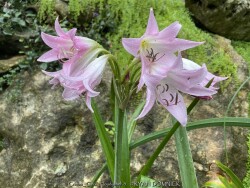

Crinums are tough, long-lived perennial bulbs with strappy leaves and fragrant, funnel-shaped flowers. In areas where the bulbs are hardy, (zones 5/6-10) these plants can reach as much as 4 feet across and bloom all summer. Crinums can live for 200-300 years in the South often found growing in cemeteries and abandoned home sites with little or no attention. The plants are native to southeast Asia often in areas with a summer monsoon and dry winter. They can also be grown as flowering summer patio plants. If growing as a potted plant and trying to overwinter, allowing the foliage to frost is ok, it will not kill the root system. However, do not allow the pot with rootball to freeze solid or go below 20 degrees for more than a few hours; move into a cold garage or basement over the winter with no watering. Cut back and allow to go dormant and place entire pot back out in April or May with a time-release fertilizer. During the growing season, fertilize, water regularly, and place in full sun. You may also plant these in the ground for an enormous tropical effect! It is easy to overwinter these in the ground in Kansas with mulch or no mulch! The trick is to plant them deep: an extra 4-6" deeper than grade or with neck of bulb completely buried. Crinums are extremely adaptable thriving in either in dry or in boggy soils. Crinums are tough, low maintenance bulbs which make them perfect for rain gardens, and although drought-tolerant, crinums bloom more if well-watered. This plant can also grow in standing water or as a potted plant in water gardens. Unlike southern climates, crinums in Kansas need full sun to grow and flower in our shorter growing season. Crinum are more cold hardy than most authorities publish; easily pushing into zone 5 for some varieties. In our trial gardens in Lawrence, KS (zone 6a), the following varieties survived after being mulched 6-12" with leaf mulch to -17 degrees F. (Crinum 'Infusion', Crinum tweedianum, Crinum 'Super Ellen', Crinum x powellii, Crinum 'White Prince') During the arctic blast of February, 2021, lows down to -17 degrees F on Feb 16th, 2021 were recorded. The longevity of this cold blast was also impressive: 10 days on a row with highs of 10-15 degrees F or lower, 8 nights of lows in the single digits and negatives, and 36 straight hours of 0 degrees F and mostly lower. No crinums were lost or harmed during this event! Crinum x powellii produces pink flowers. 48" tall
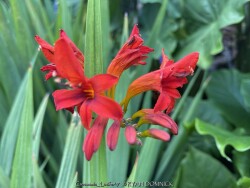

Lucifer Red Crocosmia (Crocosmia 'Lucifer') are typically grown for their bright red mid-summer flowers and vertical iris-leaf foliage. The plants are temperate and subtropical herbaceous perennial bulbs native to areas with a summer wet season and dry winter. Crocosmia are hardy outside as a perennial when established and with minimal effort at least up to zone 6a. During the growing season, fertilize, water regularly, and plant in full sun. Plant these bulbs in the ground at least 4-6" deep with 3-4" of mulch to enjoy a wonderful tropical flowering effect! Foliage may look bedwraggled by fall so it is ok to cut back foliage at that time. They can also be grown as a flowering summer patio plant. If growing as a potted plant and trying to overwinter, allowing the foliage to frost is ok, it will not kill the root system. However, do not allow the pot with rootball to freeze solid or go below 20 degrees for more than a few hours; move into a cold garage or basement over the winter with no watering. Cut back and allow to go dormant and place entire pot back out in April or May with a time-release fertilizer. Another more labor intensive way to overwinter crocosmia is to remove them from the dirt, dust with fungicide, place in box with sawdust, and keep in the refrigerator. We consider this method old-fashioned and too much work but ok if you only want to save a few bulbs. If digging from the ground in colder zones, just save a big chunk with the dirt intact and place into a large pot in the garage. In a customer's garden in Lawrence, KS (zone 6a), four established specimens planted over 4-6" deep and mulched 2-3" with wood mulch survived -17 degrees F. During the arctic blast of February, 2021, lows down to -17 degrees F on Feb 16th, 2021 were recorded. The longevity of this cold blast was also impressive: 10 days on a row with highs of 10-15 degrees F or lower, 8 nights of lows in the single digits and negatives, and 36 straight hours of 0 degrees F and mostly lower.
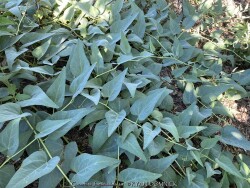

Buffalo Gourd (Cucurbita foetidissima) has large, gray-green, triangular leaves growing along long, prostrate stems. In the wild, the plants are often 20-30 feet across. Leaves are an attractive bluish green with a sandpapery texture. The large, bell-like flowers, 2-4 inches long, are yellow to orange, opening for only a day but blooming occurs over a month or so. The globular fruits, about 4 inches across, are green-striped when young, maturing to tennis-ball size and turning yellow. The plant supposedly gets the name "stink gourd" from its foul odor. Native to arid clay soils in Western Kansas, Colorado, the southwestern United States, and northern Mexico, the plant forms a fleshy tap root which is used to store water and nutrients. A large 10' wide specimen has flourished in our display garden in Lawrence, KS for over 10 years. It is planted in full sun in clay soil with no extra irrigation. It survived -16 degrees F and a week of single digit highs in February, 2021. It would be very useful as a vine-like perennial cascading over the top of a retaining wall! Amazing that a perennial native to areas receiving 5-10" of rain per year can grow in a climate receiving 5-10 times more rain!
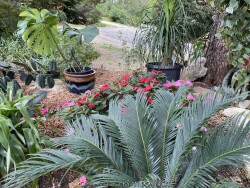

Cycad / Sago Palm (Tropical), is also known as Cycas revoluta


This upright Cholla Cactus (Cylindropuntia imbricata) features magenta flowers and upright growth form are a unique addition to the garden. Native to arid clay soils in Western Kansas, Colorado, Oklahoma and parts of the southwestern United States and Mexico, the plant grows into a vicious unforgiving shrub if you get too close. From a distance however, this cactus has a place as one of the few upright cacti that can handle extreme cold. In fact, I have seen this species growing a few times in Lawrence, KS in desert gardens and even in full (dry) shade! Flowering in shade is doubtful though. With well drained soils and proper siting, this cactus can handle our excess rainfall in Eastern Kansas.
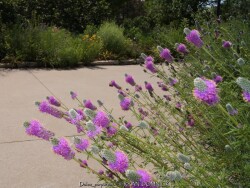

Great Plains Magenta Bush Clover, is also known as Dalea purpurea
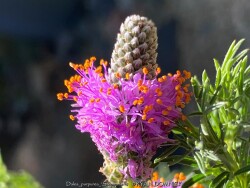

Great Plains Magenta Bush Clover, is also known as Dalea purpurea 'Stephanie'
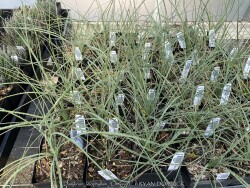

***Description for this plant available with future update!***
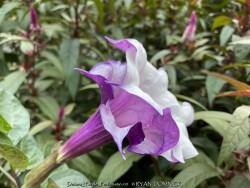

***Description for this plant available with future update!***
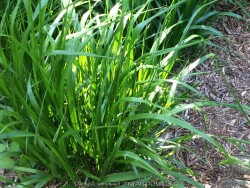

American Beakgrain (Diarrhena obovata) as a native ornamental grass found in rich woodlands in eastern North America. It features bright glossy green foliage about 2 feet tall. It is strongly vertical with little flopping until Seed heads weigh it down late in the season. With it being somewhat of a rarity to have an ornamental grass tolerate shade, American beak grass Along with inland sea oats and Korean Feather Grass help fill that niche. American beak grass prefers rich average to moist soil but will tolerate some dry shade of in rich soil. Seed heads are attractive but not persisting very long: it is an excellent source of food for birds and small mammals. Fall color is a gorgeous golden tint. Seedlings will germinate freely in the area around the mother plants. If this is not desired, simply keep the area mulched. Spreading by rhizomes will also occur after a few years. For the home garden in rich well irrigated areas, this species can be too aggressive. Use as a mass planting in any shaded area allowing extra room. However, in a difficult dry-shade garden, it will thrive, flower, and be relatively tame without much spread. Mulch will also stop self-seeding. It is one of the few plants that can survive under an established Silver Maple! Now if you need a plant to prevent soil erosion along streams, use this re-seeding to your advantage! As it reseeds easily and can expand aggressively within a couple of years, it makes a solid root mat in moist erosion-prone loam soils.
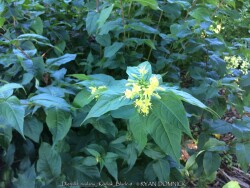

Looking for an adaptable native plant that's drought-tolerant, deer-resistant and colorful? This is it! Diervilla just got a lot more colorful: this tough, easy-growing shrub (Diervilla rivularis 'Kodiak Black') is a standout with its dark burgundy-black foliage. The color is especially intense in spring and autumn. The bright yellow flowers add contrast in early summer. This is a durable native that thrives in sun or shade, and is a very useful landscape plant.Top three reasons to grow Kodiak® Black Diervilla:1.One of the best shade-tolerant shrubs (though color is more intense in sun or part shade) 2.Never without clusters of yellow flowers during the summer 3.Dramatic black-purple foliage all season with vivid red tones in autumn. Uses Notes:Naturalizing; mass plantings. Maintenance Notes: Adaptable to most soils, including dry ones. Trim in spring and apply a controlled-release fertilizer. Though it is sometimes called "bush honeysuckle," Diervilla is not invasive. In Eastern Kansas, this cultivar performs WELL with just about everything nature has to challenge it! Heat and drought are tolerated if in shade or morning sun. Cold tolerance is no problem. No disease or pest problems. Great plant for dry-shade. Native to North America. All Proven Winners® plants are legally propagated, healthy and vigorous, true to name, and tagged with color pictures and growing information.
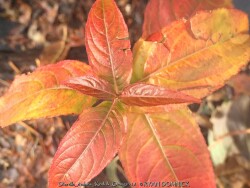

Looking for a durable native plant that will thrive in sun or shade, and is drought-tolerant? Deer-resistant, too? You've got it! This shrub (Diervilla rivularis 'Kodiak Orange') pushes fall color to the limits with its glowing orange fall foliage. It lights up the fall landscape, making it an eco friendly alternative to burning bush. Bright yellow flowers in early summer add to its appeal. A durable native plant that thrives in sun or shade, its is drought-tolerant, deer-resistant, and can even grow in dry shade. This is an excellent landscape plant that will succeed in even challenging sites. Top three reasons to grow Kodiak® Orange diervilla: 1.Tolerant of dry shade (though color is best with at least some sun) 2.Never without yellow flower clusters in the summer. 3.Orange new growth and glowing orange-red fall foliage. Uses Notes: Naturalizing; mass plantings. Maintenance Notes: Adaptable to most soils, including dry ones. Trim in spring and apply a controlled-release fertilizer. Though it is sometimes called "bush honeysuckle," Diervilla is not invasive like certain honeysuckles are. In Eastern Kansas, this cultivar performs WELL with just about everything nature has to challenge it! Heat and drought are tolerated if in shade or morning sun. Cold tolerance is no problem. No disease or pest problems. Great plant for dry-shade. Native to North America. All Proven Winners® plants are legally propagated, healthy and vigorous, true to name, and tagged with color pictures and growing information.
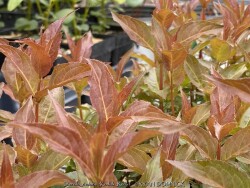

Kodiak® Red Diervilla (Diervilla rivularis 'Kodiak Red') provides rugged beauty for the toughest spots in your landscape. Kodiak® Red diervilla is a native flowering shrub that looks great while shrugging off shade and problem soils. New growth emerges in spring with a deep burgundy tone, and turns vivid red in fall. During summer, leaves have a red edge and clusters of small yellow flowers appear all season. It's a simple but beautiful way to add low-maintenance color to parts of your yard that have been difficult to landscape. Top reasons to grow Kodiak Red diervilla: 1.One of the toughest landscape plants around! 2.Foliage emerges red and turns bright red in fall. 3.Yellow flowers all summer long. Diervilla needs very little care - if you'd like to prune it, do so in early spring. It does not require regular pruning, but if it starts to get a little sparse as it matures, cut it back to the ground in early spring for a fresh start. Uses Notes: The long, straight stems and neat foliage of diervilla makes it an excellent filler for cut flower arrangements. Maintenance Notes: Diervilla needs very little care - if you'd like to prune it, do so in early spring. It does not require regular pruning, but if it starts to get a little sparse as it matures, cut it back to the ground in early spring for a fresh start. Diervilla is sometimes called "bush honeysuckle," and though it is related to honeysuckle, diervilla flowers are not fragrant. However, more importantly, diervilla is NOT invasive, so it's a safe choice for planting anywhere. In Eastern Kansas, this cultivar performs WELL with just about everything nature has to challenge it! Heat and drought are tolerated if in shade or morning sun. Cold tolerance is no problem. No disease or pest problems. Great plant for dry-shade. Native to North America. All Proven Winners® plants are legally propagated, healthy and vigorous, true to name, and tagged with color pictures and growing information.
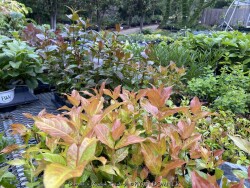

Looking for a durable native plant that will thrive in sun or shade, and is drought-tolerant? Deer-resistant, too? You've got it! This shrub (Diervilla x 'Kodiak Fresh') gives a new look to Diervilla with its bright lime-yellow foliage in summertime, always accompanied by bright yellow flowers. Like the other members of the Kodiak series, it lights up the fall landscape, making it an eco-friendly alternative to burning bush. A durable native plant that thrives in sun or shade, it is drought-tolerant, deer-resistant, and can even grow in dry shade. This is an excellent landscape plant that will succeed in even challenging sites. Top three reasons to grow Kodiak® Fresh diervilla: 1.Tolerant of dry shade (though color is best with at least some sun) 2.Never without yellow flower clusters in the summer. 3.Orangey-red new growth, persistent lime coloring, and glowing orange fall foliage. Uses Notes: Naturalizing; mass plantings. Maintenance Notes: Adaptable to most soils, including dry ones. Trim in spring and apply a controlled-release fertilizer. Though it is sometimes called "bush honeysuckle," Diervilla is not invasive like certain honeysuckles are. In Eastern Kansas, this cultivar performs WELL with just about everything nature has to challenge it! Heat and drought are tolerated if in shade or morning sun. Cold tolerance is no problem. No disease or pest problems. Great plant for dry-shade. Native to North America. All Proven Winners® plants are legally propagated, healthy and vigorous, true to name, and tagged with color pictures and growing information.
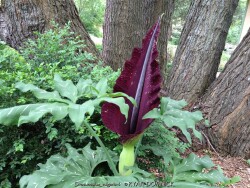

Voodoo lily (Dracunculus vulgaris) is a perennial tuber generally grown as a curiosity for its interesting foliage. The single leaf consists of a stalk (petiole) with mottled pinkish-gray and olive green coloration. The single intricate leaf has horizontal sections giving it a tropical umbrella-like effect. Larger tubers (about the size of a grapefruit or larger) may produce a single "flower" in spring before the foliage appears. The "flower" is actually a large shiny purple to maroon ruffled spathe. When in bloom it produces an odor like a dead animal for 1 day. This is intended to attract the carrion flies that are its natural pollinators. It is possible to overwinter these in the ground in Kansas by placing a 6-12" mound of mulch over deeply planted tubers. New growth will usually be delayed until June but quickly regains full height and will get bigger each year; buried tubers are hardy to zone 6a. They can also be grown as a flowering summer patio plant. If growing as a potted plant and trying to overwinter, allowing the foliage to frost is ok, it will not kill the root system. However, do not allow the pot with rootball to freeze solid or go below 20 degrees for more than a few hours; move into a cold garage or basement over the winter with no watering. Cut back and allow to go dormant and place entire pot back out in April or May with a time-release fertilizer.
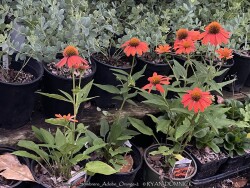

>>>>> Echinacea purpurea is an herbaceous perennial native to parts of eastern and midwestern United States most common in Missouri and Arkansas. Its habitats include dry open woods, prairies and barrens. Echinacea are native to North America, featuring sunflower-like flowers with a dark center and colorful petals. Colors on native plants include purple, magenta, white, yellow. Intensive breeding efforts to fish out recessive genes have brought bright orange and red into the picture. Flowers occur in early to mid summer often continuing into fall especially if dead-headed. Its individual flowers (florets) within the flower head are two-toned, having both male and female organs in each flower. (hermaphroditic) Bees and butterflies including the monarch are common pollinators. The dead flowers are attractive to some for winter interest but for those wanting a tidy your garden, they can be trimmed early. Leaving some dried seed heads will be beneficial for wildlife and provide winter food for finches and other birds. Best growth generally occurs in full to part sun with well drained soils with low to average moisture. In Eastern Kansas, typically our 40 inches of rainfall is sufficient without extra water. Coneflower can also handle short one to two day flooding events and are sometimes used along the higher perimeter of rain gardens to bring in pollinators. Coneflower mixes well with many other types of plants ranging from other native plants to evergreens to hardy tropicals. Rabbits can be a problem young immature plants. A popular method of control is covering the plant with an upside down bowl-shaped chicken wire cage for the first year to allow basil foliage to establish well. You can quickly make these yourself with a low cost roll of chicken wire. Mature plants especially in groups with other mature landscaping generally do not have rabbit problems. Flowers are also popular in the florist industry as cut flowers or in the cottage garden. The genus echinacea has undergone intense breeding with the introduction of hundreds of new cultivars in the last 10 years.
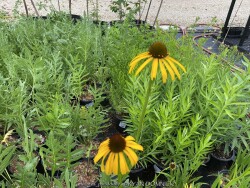

>>>>> Echinacea purpurea is an herbaceous perennial native to parts of eastern and midwestern United States most common in Missouri and Arkansas. Its habitats include dry open woods, prairies and barrens. Echinacea are native to North America, featuring sunflower-like flowers with a dark center and colorful petals. Colors on native plants include purple, magenta, white, yellow. Intensive breeding efforts to fish out recessive genes have brought bright orange and red into the picture. Flowers occur in early to mid summer often continuing into fall especially if dead-headed. Its individual flowers (florets) within the flower head are two-toned, having both male and female organs in each flower. (hermaphroditic) Bees and butterflies including the monarch are common pollinators. The dead flowers are attractive to some for winter interest but for those wanting a tidy your garden, they can be trimmed early. Leaving some dried seed heads will be beneficial for wildlife and provide winter food for finches and other birds. Best growth generally occurs in full to part sun with well drained soils with low to average moisture. In Eastern Kansas, typically our 40 inches of rainfall is sufficient without extra water. Coneflower can also handle short one to two day flooding events and are sometimes used along the higher perimeter of rain gardens to bring in pollinators. Coneflower mixes well with many other types of plants ranging from other native plants to evergreens to hardy tropicals. Rabbits can be a problem young immature plants. A popular method of control is covering the plant with an upside down bowl-shaped chicken wire cage for the first year to allow basil foliage to establish well. You can quickly make these yourself with a low cost roll of chicken wire. Mature plants especially in groups with other mature landscaping generally do not have rabbit problems. Flowers are also popular in the florist industry as cut flowers or in the cottage garden. The genus echinacea has undergone intense breeding with the introduction of hundreds of new cultivars in the last 10 years.
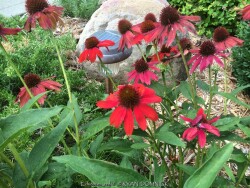

>>>>> Echinacea purpurea is an herbaceous perennial native to parts of eastern and midwestern United States most common in Missouri and Arkansas. Its habitats include dry open woods, prairies and barrens. Echinacea are native to North America, featuring sunflower-like flowers with a dark center and colorful petals. Colors on native plants include purple, magenta, white, yellow. Intensive breeding efforts to fish out recessive genes have brought bright orange and red into the picture. Flowers occur in early to mid summer often continuing into fall especially if dead-headed. Its individual flowers (florets) within the flower head are two-toned, having both male and female organs in each flower. (hermaphroditic) Bees and butterflies including the monarch are common pollinators. The dead flowers are attractive to some for winter interest but for those wanting a tidy your garden, they can be trimmed early. Leaving some dried seed heads will be beneficial for wildlife and provide winter food for finches and other birds. Best growth generally occurs in full to part sun with well drained soils with low to average moisture. In Eastern Kansas, typically our 40 inches of rainfall is sufficient without extra water. Coneflower can also handle short one to two day flooding events and are sometimes used along the higher perimeter of rain gardens to bring in pollinators. Coneflower mixes well with many other types of plants ranging from other native plants to evergreens to hardy tropicals. Rabbits can be a problem young immature plants. A popular method of control is covering the plant with an upside down bowl-shaped chicken wire cage for the first year to allow basil foliage to establish well. You can quickly make these yourself with a low cost roll of chicken wire. Mature plants especially in groups with other mature landscaping generally do not have rabbit problems. Flowers are also popular in the florist industry as cut flowers or in the cottage garden. The genus echinacea has undergone intense breeding with the introduction of hundreds of new cultivars in the last 10 years.


Pale Purple Coneflower, is also known as Echinacea pallida
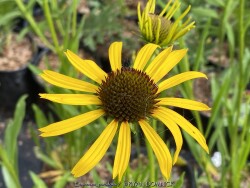

Yellow Coneflower, is also known as Echinacea paradoxa
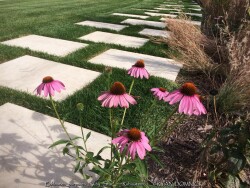

>>>>>Echinacea purpurea is an herbaceous perennial native to parts of eastern and midwestern United States most common in Missouri and Arkansas. Its habitats include dry open woods, prairies and barrens. Echinacea are native to North America, featuring sunflower-like flowers with a dark center and colorful petals. Colors on native plants include purple, magenta, white, yellow. Intensive breeding efforts to fish out recessive genes have brought bright orange and red into the picture. Flowers occur in early to mid summer often continuing into fall especially if dead-headed. Its individual flowers (florets) within the flower head are two-toned, having both male and female organs in each flower. (hermaphroditic) Bees and butterflies including the monarch are common pollinators. The dead flowers are attractive to some for winter interest but for those wanting a tidy your garden, they can be trimmed early. Leaving some dried seed heads will be beneficial for wildlife and provide winter food for finches and other birds. Best growth generally occurs in full to part sun with well drained soils with low to average moisture. In Eastern Kansas, typically our 40 inches of rainfall is sufficient without extra water. Coneflower can also handle short one to two day flooding events and are sometimes used along the higher perimeter of rain gardens to bring in pollinators. Coneflower mixes well with many other types of plants ranging from other native plants to evergreens to hardy tropicals. Rabbits can be a problem young immature plants. A popular method of control is covering the plant with an upside down bowl-shaped chicken wire cage for the first year to allow basil foliage to establish well. You can quickly make these yourself with a low cost roll of chicken wire. Mature plants especially in groups with other mature landscaping generally do not have rabbit problems. Flowers are also popular in the florist industry as cut flowers or in the cottage garden. The genus echinacea has undergone intense breeding with the introduction of hundreds of new cultivars in the last 10 years. Sunset Coneflower / Red-Orange Coneflower (Echinacea x Sunset) features red-orange and pinkish flowers. Most orange or red types if allowed to self-seed will produce purple flowering plants.
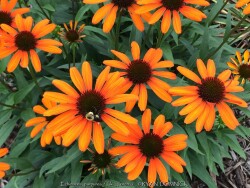

Echinacea purpurea is an herbaceous perennial native to parts of eastern and midwestern United States most common in Missouri and Arkansas. Its habitats include dry open woods, prairies and barrens. Echinacea are native to North America, featuring sunflower-like flowers with a dark center and colorful petals. Colors on native plants include purple, magenta, white, yellow. Intensive breeding efforts to fish out recessive genes have brought bright orange and red into the picture. Flowers occur in early to mid summer often continuing into fall especially if dead-headed. Its individual flowers (florets) within the flower head are two-toned, having both male and female organs in each flower. (hermaphroditic) Bees and butterflies including the monarch are common pollinators. The dead flowers are attractive to some for winter interest but for those wanting a tidy your garden, they can be trimmed early. Leaving some dried seed heads will be beneficial for wildlife and provide winter food for finches and other birds. Best growth generally occurs in full to part sun with well drained soils with low to average moisture. In Eastern Kansas, typically our 40 inches of rainfall is sufficient without extra water. Coneflower can also handle short one to two day flooding events and are sometimes used along the higher perimeter of rain gardens to bring in pollinators. Coneflower mixes well with many other types of plants ranging from other native plants to evergreens to hardy tropicals. Rabbits can be a problem young immature plants. A popular method of control is covering the plant with an upside down bowl-shaped chicken wire cage for the first year to allow basil foliage to establish well. You can quickly make these yourself with a low cost roll of chicken wire. Mature plants especially in groups with other mature landscaping generally do not have rabbit problems. Flowers are also popular in the florist industry as cut flowers or in the cottage garden. The genus echinacea has undergone intense breeding with the introduction of hundreds of new cultivars in the last 10 years. Several cultivars featuring the break-thru orange color. Older varieties were less vigorous but new varieties are much improved. Most orange or red types if allowed to self-seed will produce purple flowering plants.
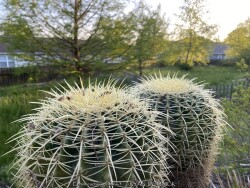

Golden Barrel Cacti (Echinocactus grusonii) are known for their bright yellow spines. Native to deserts in Mexico, it's usually grown as a patio or house plant in Kansas. In the wild, established golden barrel cacti are hardy to 13 degrees F for short periods of time. Grow in full sun with no extra watering except that which comes from rainfall. Repotting may or may not be needed depending on how large you want the plant to grow; plants can continue to grow taller and tolerate extremely root-bound pots but may need wind bracing. If repotting, make sure to use a sharp draining low organic cactus mix with plenty of sand and perlite. Potted plants are hardy to at least 25 degrees F for a short time if kept dry so you are ok if you miss the first light frost. Do not allow the pot with rootball to freeze solid though. Before extreme cold occurs, move to a bright interior window over the winter with no watering and keep above freezing. As a winter house plant, it will look presentable all winter long with just no waterings.(also to prevent soft winter growth) As a permanent house plant, provide bright light and allow the soil to dry between waterings for many years of carefree enjoyment. Plants grown permanently indoors may begin to elongate stretching for light and lose their spine color. It can be hard to reproduce the intense UV sunlight they need so moving outside for the summer is best. Generally if moving outside for the summer, allow 1-2 weeks of part shade or morning sun before placing in full sun. Plants with time to acclimate will thrive in full sun but be careful not to rush it or sunburning will occur. Potted plants are very low maintenance. I have never seen any insect problems on this plant.


Grown for its beautiful bluish-green skin and relatively few spines, San Pedro Cactus () is usually a patio or house plant in Kansas. Because it grows naturally in the Peruvian Andes Mountains at high altitude and with high rainfall, it can withstand temperatures far below that of many other cacti. In the wild, this species is hardy to 15-20 degrees F for short periods of time. Grow in full sun with optional extra watering including that which comes from rainfall. Repotting may or may not be needed depending on how large you want the plant to grow; plants can continue to grow taller and tolerate extremely root-bound pots but may need wind bracing. If repotting, make sure to use a sharp draining medium organic cactus mix with plenty of sand and perlite. To play is safe, potted plants are best moved in before night temperatures get below 45 degrees F. It is important to avoid the combination of wet and cold. Before extreme cold occurs, move to a bright interior window over the winter with no watering and keep above freezing. As a winter house plant, it will look presentable all winter long with just no waterings.(also to prevent lanky winter growth) As a permanent house plant, provide bright light and allow the soil to dry between waterings for many years of carefree enjoyment. Plants grown permanently indoors may begin to elongate stretching for light producing weak new growth. It can be hard to reproduce the intense UV sunlight they need so moving outside for the summer is best. Generally if moving outside for the summer, allow 1-2 weeks of part shade or morning sun before placing in full sun. Plants with time to acclimate will thrive in full sun but be careful not to rush it or sunburning will occur. Potted plants are very low maintenance. I have never seen any insect problems on this plant. The San Pedro cactus contains a number of alkaloids, including the well-studied chemical mescaline. In the US, it is currently legal to cultivate the San Pedro cactus for gardening and ornamental purposes, but not for consumption.
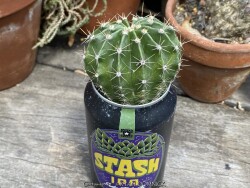

Sea Urchin Cactus (Echinopsis sp.) is a large genus of cacti native to South America, sometimes known as hedgehog cactus. Grown for its beautiful tubular flowers, it's usually a patio or house plant in Kansas. In the wild, some species are hardy to 15-20 degrees F for short periods of time. Grow in full sun with no extra watering except that which comes from rainfall. Repotting may or may not be needed depending on how large you want the plant to grow; plants can continue to grow taller and tolerate extremely root-bound pots but may need wind bracing. If repotting, make sure to use a sharp draining low organic cactus mix with plenty of sand and perlite. To play is safe, potted plants are best moved in before night temperatures get below 45 degrees F. It is important to avoid the combination of wet and cold. Before extreme cold occurs, move to a bright interior window over the winter with no watering and keep above freezing. As a winter house plant, it will look presentable all winter long with just no waterings. As a permanent house plant, provide bright light and allow the soil to dry between waterings for many years of carefree enjoyment. Plants grown permanently indoors may begin to elongate stretching for light and lose their spine color. It can be hard to reproduce the intense UV sunlight they need so moving outside for the summer is best. Generally if moving outside for the summer, allow 1-2 weeks of part shade or morning sun before placing in full sun. Plants with time to acclimate will thrive in full sun but be careful not to rush it or sunburning will occur. Potted plants are very low maintenance. I have never seen any insect problems on this plant.
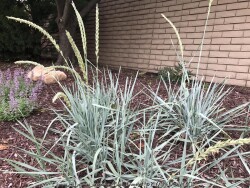

Blue Dune Lyme Grass, is also known as Elymus / Leymus arenarius 'Blue Dune'


Barrenwort (Epimedium) features compact dainty mounds of green to colored weed-resistant foliage. Wispy flowers appear above emerging foliage in mid-spring. Improved breeding has resulted in many different flower colors even including orange. Semi-evergreen foliage can sometimes look bedraggled by late summer if there is too much overhead watering and humidity. Barrenwort prefers average to dry garden conditions and even thrive and dry shade. Plantings can thrive for decades if in the right spot; there is no such thing as overcrowding for Barrenwort. When planted in mass, growth is slow at first but eventually a cake-like rhizome system will form and completely smother out any weeds and compete well with trees for water and nutrients. While barrenwort can tolerate full sun, they prefer part to full shade. Sun burning is possible with temperatures over 100° and there are better plants to use in hot areas. Due to slow spreading growth, you shouldn't leave very much room in-between barrenwort plants or you will be waiting many years for the patch to fill in. Weeds can be a problem in that open area between plants if spacing is too wide. We recommend 9-12" spacing and use for small nooks in the shade garden. If planning for a larger area, still figure on the tight spacing but allow for a higher budget that you will consider a permanent investment. Barrenwort is a real trooper for the dry shade garden!
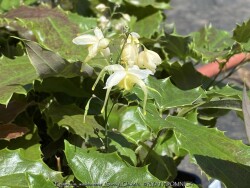

Barrenwort (Epimedium) features compact dainty mounds of green to colored weed-resistant foliage. Wispy flowers appear above emerging foliage in mid-spring. Improved breeding has resulted in many different flower colors even including orange. Semi-evergreen foliage can sometimes look bedraggled by late summer if there is too much overhead watering and humidity. Barrenwort prefers average to dry garden conditions and even thrive and dry shade. Plantings can thrive for decades if in the right spot; there is no such thing as overcrowding for Barrenwort. When planted in mass, growth is slow at first but eventually a cake-like rhizome system will form and completely smother out any weeds and compete well with trees for water and nutrients. While barrenwort can tolerate full sun, they prefer part to full shade. Sun burning is possible with temperatures over 100° and there are better plants to use in hot areas. Due to slow spreading growth, you shouldn't leave very much room in-between barrenwort plants or you will be waiting many years for the patch to fill in. Weeds can be a problem in that open area between plants if spacing is too wide. We recommend 9-12" spacing and use for small nooks in the shade garden. If planning for a larger area, still figure on the tight spacing but allow for a higher budget that you will consider a permanent investment. Barrenwort is a real trooper for the dry shade garden! Sandy Claws Barrenwort (Epimedium wushanense 'Sandy Claws') features long, lance-shaped leaves and spiny margins (not sharp). Newly emerging foliage has dramatic maroon coloring unique to the shade garden. The color mellows to dark green by summer. The cream-colored flowers contrast beautifully with the brilliantly colored foliage. Growth is faster and height is taller at 12-16" Albeit still slow compared to other perennials.
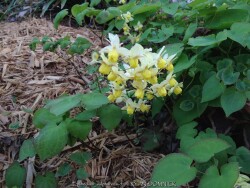

Barrenwort (Epimedium) features compact dainty mounds of green to colored weed-resistant foliage. Wispy flowers appear above emerging foliage in mid-spring. Improved breeding has resulted in many different flower colors even including orange. Semi-evergreen foliage can sometimes look bedraggled by late summer if there is too much overhead watering and humidity. Barrenwort prefers average to dry garden conditions and even thrive and dry shade. Plantings can thrive for decades if in the right spot; there is no such thing as overcrowding for Barrenwort. When planted in mass, growth is slow at first but eventually a cake-like rhizome system will form and completely smother out any weeds and compete well with trees for water and nutrients. While barrenwort can tolerate full sun, they prefer part to full shade. Sun burning is possible with temperatures over 100° and there are better plants to use in hot areas. Due to slow spreading growth, you shouldn't leave very much room in-between barrenwort plants or you will be waiting many years for the patch to fill in. Weeds can be a problem in that open area between plants if spacing is too wide. We recommend 9-12" spacing and use for small nooks in the shade garden. If planning for a larger area, still figure on the tight spacing but allow for a higher budget that you will consider a permanent investment. Barrenwort is a real trooper for the dry shade garden! Epimedium x versicolor 'Sulphureum' is a faster spreading, more robust yellow flowering variety. Albeit still very slow compared to other perennials.
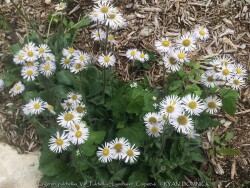

Robin's Plantain / Fleabane, is also known as Erigeron pulchellus var. pulchellus 'Lynnhaven Carpet'
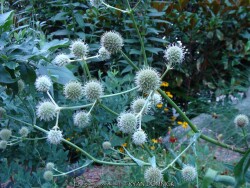

Rattlesnake Master / Eryngium, is also known as Eryngium yuccifolium
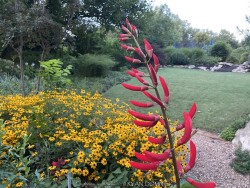

>>>>>In our trial gardens in Lawrence, KS (zone 6a), an established specimen planted on the south wall of a house with 6-12" of leaf mulch survived -17 degrees F. During the arctic blast of February, 2021, lows down to -17 degrees F on Feb 16th, 2021 were recorded. The longevity of this cold blast was also impressive: 10 days on a row with highs of 10-15 degrees F or lower, 8 nights of lows in the single digits and negatives, and 36 strait hours of 0 degrees F and mostly lower.
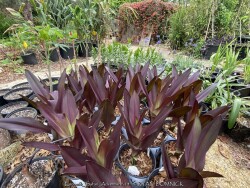

Safari Adventure Pineapple Lily (Eucomis comosa 'Safari Adventure') is typically grown for their wide tropical foliage and pineapple-like flowers. Deep purple foliage contrasts well with many other flower colors. The plants are temperate and subtropical herbaceous perennial bulbs native to areas with a summer wet season and dry winter. Pineapple Lily are hardy outside as a perennial when established and with minimal effort at least up to zone 6a. During the growing season, fertilize, water regularly, and plant in full sun. Plant these bulbs in the ground at least 6-8" deep with 3-4" of mulch to enjoy a wonderful tropical effect! Foliage may look bedwraggled by fall so it is ok to cut back foliage at that time. They can also be grown as a flowering summer patio plant. If growing as a potted plant and trying to overwinter, allowing the foliage to frost is ok, it will not kill the root system. However, do not allow the pot with rootball to freeze solid or go below 20 degrees for more than a few hours; move into a cold garage or basement over the winter with no watering. Cut back and allow to go dormant and place entire pot back out in April or May with a time-release fertilizer. Another more labor intensive way to overwinter pineapple lily is to remove them from the dirt, dust with fungicide, place in box with sawdust, and keep in the refrigerator. We consider this method old-fashioned and too much work but ok if you only want to save a few bulbs. If digging from the ground in colder zones, just save a big chunk with the dirt intact and place into a large pot in the garage.
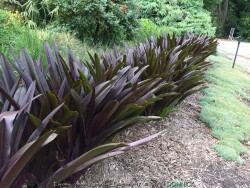

Sparkling Burgundy Pineapple Lily (Eucomis comosa 'Sparkling Burgundy') are typically grown for their wide tropical foliage and pineapple-like flowers. Deep purple foliage contrasts well with many other flower colors. The plants are temperate and subtropical herbaceous perennial bulbs native to areas with a summer wet season and dry winter. Pineapple Lily are hardy outside as a perennial when established and with minimal effort at least up to zone 6a. During the growing season, fertilize, water regularly, and plant in full sun. Plant these bulbs in the ground at least 6-8" deep with 3-4" of mulch to enjoy a wonderful tropical effect! Foliage may look bedwraggled by fall so it is ok to cut back foliage at that time. They can also be grown as a flowering summer patio plant. If growing as a potted plant and trying to overwinter, allowing the foliage to frost is ok, it will not kill the root system. However, do not allow the pot with rootball to freeze solid or go below 20 degrees for more than a few hours; move into a cold garage or basement over the winter with no watering. Cut back and allow to go dormant and place entire pot back out in April or May with a time-release fertilizer. Another more labor intensive way to overwinter pineapple lily is to remove them from the dirt, dust with fungicide, place in box with sawdust, and keep in the refrigerator. We consider this method old-fashioned and too much work but ok if you only want to save a few bulbs. If digging from the ground in colder zones, just save a big chunk with the dirt intact and place into a large pot in the garage. In our display garden in Lawrence, KS (zone 6a), an established specimen planted over 4-6" deep and mulched 2-3" with wood mulch survived -17 degrees F. During the arctic blast of February, 2021, lows down to -17 degrees F on Feb 16th, 2021 were recorded. The longevity of this cold blast was also impressive: 10 days on a row with highs of 10-15 degrees F or lower, 8 nights of lows in the single digits and negatives, and 36 straight hours of 0 degrees F and mostly lower. This eucomis has survived for over 10 years and other extreme cold blasts in the past.


Giant Pineapple Lily (Eucomis pallidiflora ssp. pole-evansii) are typically grown for their wide tropical foliage and giant pineapple-like flowers. Everything about this pineapple lily is large! Bright green foliage upto 3 feet tall contrasts well with many other flower colors. The plants are temperate and subtropical herbaceous perennial bulbs native to areas with a summer wet season and dry winter. Pineapple Lily are hardy outside as a perennial when established and with minimal effort at least up to zone 6a. During the growing season, fertilize, water regularly, and plant in full sun. Plant these bulbs in the ground at least 8-12" deep with 3-4" of mulch to enjoy a wonderful tropical effect! Foliage may look bedwraggled by fall so it is ok to cut back foliage at that time. They can also be grown as a flowering summer patio plant. If growing as a potted plant and trying to overwinter, allowing the foliage to frost is ok, it will not kill the root system. However, do not allow the pot with rootball to freeze solid or go below 20 degrees for more than a few hours; move into a cold garage or basement over the winter with no watering. Cut back and allow to go dormant and place entire pot back out in April or May with a time-release fertilizer. Another more labor intensive way to overwinter pineapple lily is to remove them from the dirt, dust with fungicide, place in box with sawdust, and keep in the refrigerator. We consider this method old-fashioned and too much work but ok if you only want to save a few bulbs. If digging from the ground in colder zones, just save a big chunk with the dirt intact and place into a large pot in the garage. In our display garden in Lawrence, KS (zone 6a), an established specimen planted over 4-6" deep and mulched 2-3" with wood mulch survived -17 degrees F. During the arctic blast of February, 2021, lows down to -17 degrees F on Feb 16th, 2021 were recorded. The longevity of this cold blast was also impressive: 10 days on a row with highs of 10-15 degrees F or lower, 8 nights of lows in the single digits and negatives, and 36 straight hours of 0 degrees F and mostly lower. This eucomis has survived for over 3 years now.
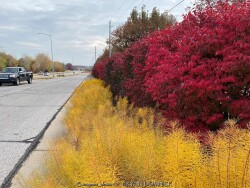

***Shrub descriptions available with future update!*** >>>>> Spring Meadow Nursery says "Better stem hardiness than typical dwarf burning bush. Fire Ball® burning bush is an improved selection of compact burning bush with tighter branching and superior hardiness. Other varieties of burning bush may experience die-back during harsh winters; Fire Ball® euonymus has experienced zero damage even in the coldest of Midwestern winters"